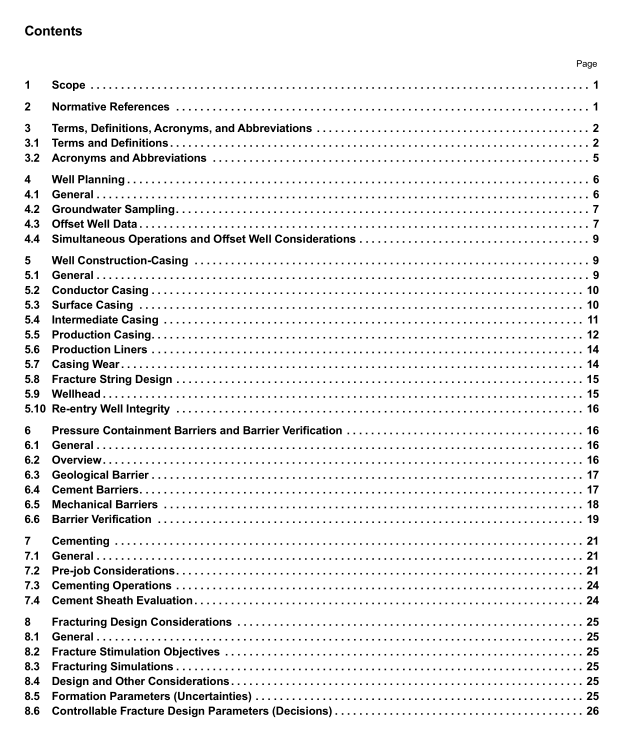API 100-1 pdf download

API 100-1 pdf download Hydraulic Fracturing—Well Integrity and Fracture Containment
Confirmation of wellbore integrity is required in order to preserve isolation of useable quality groundwater and other distinct formations, thereby providing an integral conduit for production to the surface gathering system. An operator should have documentation and guidance on casing design, based on accepted industry
5.1.2 practice. Casing used in oil and gas wells should meet API 5CT or similar industry standards that can be mandated by a governmental or regulatory body for the protection of useable quality groundwater and the overall wellbore integrity. Casing strings used in a well should be designed to withstand the anticipated load-cases to which they will be exposed or subjected, including drilling, workover, hydraulic fracturing, production, corrosion, erosion, and other factors. The application of used casing in new wells is outside the scope of this document. Well design and construction generally consists of four main components that are focused on the
5.1.3 various casing strings used. These are: conductor casing, surface, intermediate, and production. This section discusses design considerations for those casing strings that protect useable quality groundwater or contain the hydraulic fracture stimulations loads. Additional components that are discussed include fracture/tie-back strings, casing heads, production liners, and wellheads.
5.2 Conductor Casing Typically the first casing to be installed in the well is the conductor casing. The conductor casing serves as the foundation for the well. The purpose of the conductor casing is to contain the unconsolidated surface sediments and in some cases support subsequent wellhead loads. Typically, below the conductor-drive pipe, there is harder, more consolidated rock. Thus, the conductor-drive pipe keeps the unconsolidated surface sediments in place as the drilling operations proceed. Requirements for the conductor hole vary by state and area. Conductor setting depth is usually 50 ft to 100 ft (15 m to 30 m) except in areas where geotechnical constraints dictate otherwise. The conductor-drive pipe is installed either by drilling a hole or using a hammer to drive the casing. When installed by drilling a hole, the casing is cemented in place. The cement provides structural integrity and a seal to block downward migration of surface pollutants. The conductor hole shall be drilled using air or water-based fluids. There are instances where it is appropriate to hammer the conductor casing into place.
5.3 Surface Casing General
5.3.1 The primary purpose, of the surface casing string, is the protection (through isolation) of any useable quality groundwater. Surface casing is designed to meet the necessary regulatory requirements for isolating useable quality groundwater. In addition this casing string shall be suitable to contain load-cases that it may be subjected to while drilling the next hole section and prior to the setting of the next casing string. Surface Casing Depth and Useable Quality Groundwater
5.3.2 The surface hole is typically drilled to a predetermined depth based on consideration of useable quality groundwater depth, localized geology, regulatory requirements, and pressure control requirements for subsequent drilling operations. The surface hole is typically drilled using air, mist, water, or water-based drilling fluids. Local regulations often dictate the minimum setting depth of the surface casing, and the vast majority of local regulations require that the casing be set below the known useable quality groundwater at the drilling location. In the absence of regulatory guidance, the surface casing depth should be a minimum of 50 ft (15 m) below base of the groundwater. Items to consider for surface casing setting depth include
a) depth of useable quality groundwater,
b) competent formation below useable quality groundwater,
c) sufficient shoe track to manage contaminated cement,
d) potential flow zones, and
e) permafrost considerations (arctic environments only).
Casing Centralization 5.3.3
Surface casing should be centralized in order to provide adequate casing standoff for mud removal and cement placement. Centralization requirements are often specified by local regulatory agencies. Information related to centralizer selection and placement can be found in API 10TR4 and API 10D-2.









